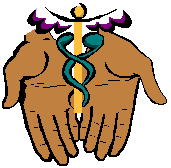 |
Helping Hands |
CPR and First Aid Training Center |
|
|
Automatic External Defibrillation, or AED, devices are beginning to gain notoriety in the non-medical arena. As more and more information about these devices is being publicized and brought into the mainstream view, you may be asking yourself several questions. What exactly is defibrillation? How well does it work? Could that device be of use in my office? Should we invest in one? I hope to be able to answer these and any other questions you might have. First, if it's been a while since your last anatomy class, I invite you to take a look at the heart. Understanding the basic functions of the heart will allow you to have a better understanding of what we will be discussing in a moment. Welcome back! Don't worry, there's not going to be a test on what you just learned. Now that we have a basic understanding of how the heart works, let's take a look at what defibrillation is. Defibrillation is when we send a very specific electrical charge through the heart to try to get the natural electrical pathways to start functioning again properly. To use an analogy, think of that hysterical guy we've all seen in a TV show or in a movie. He's very excited and unable to function properly, often screaming or running around not making any sense (that's our heart during V-Tach or V-Fib). Then the hero of the show comes up (that's the defibrillator) and slaps the hysterical guy to calm him down. The defibrillator gives the heart a jolt that momentarily stops the electrical conduction in the heart which gives it a moment to regain composure (so to speak) and then it starts again properly. Sometimes it takes more than one shock to start the heart, and sometimes even several shocks don't work at all. You might be asking yourself, "Then what good is it?" Although defibrillation doesn't work all the time, it does work in the 90% or above range. Now compare that to the less than 5% survival rate with just CPR alone. When deciding if an AED would be right for your work place, the first question is, "Is my office adult or child orientated?" AED's can not be used on children under 8 years old or under 90 pounds. If you work at a daycare center then maybe you would opt not to have the AED present in order to prevent someone from accidentally using it on one of the children instead of only the adult workers it was meant for. As for everybody else, the decision is up to you. You should ask yourself: How long would it take for the paramedics to reach one of your staff or clients if they had a heart attack? Are you near a hospital? Are you on the first or thirtieth floor? How easy is it to find your office? If an AED is applied within the first minute of sudden cardiac arrest, the survival rate is around 90%. That rate drops by 10% for every minute that the defibrillation is delayed. If you decide to purchase or look further into an AED, you now need to know who to go to. My first choice is Physio-Control. They are the industry leaders in defibrillation technology and used primarily throughout the country in hospitals and ambulances alike. While in the Navy, I used equipment of theirs that was fifteen years old and it still worked perfectly. Since most (check your local EMS system) ambulances carry the Physio-Control Life-Pak 10 defibrillator, the AED that you receive from Physio-Control would be compatible with the one that the paramedics would bring on scene. This saves time because the paramedics don't have to swap cables, they can just attach yours to their manual defibrillator and work from there (this is dependant on the model Life-Pak 10 that they are using). Also, before they leave your office, the paramedics will give you a new pair of cables to replace the ones that you used and then they will bill the victim's insurance for the item. In theory, you would never have to buy replacement cables again (some AED's have cables that cost $250 per set). Helping Hands is not currently selling or distributing AED's of any make or model. If you would like more information from Physio-Control, you can contact them at www.physiocontrol.com or at (800) 442-1142. If you have any other questions about AED's, please feel free to contact us and we will do our best to answer your questions. |